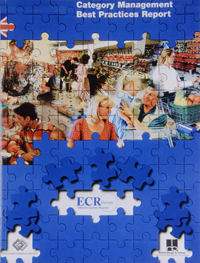- January 4, 2012
- Posted by: tpgstaging
- Category: reports

Price: Complementary
[button size=”medium” color=”black” link=”/order-now-free-publications/”]Order Now[/button]
 The Category Management Best Practices Report was a major initiative of the consumer packaged goods retailing and manufacturing industry in Europe. It was sponsored by ECR Europe. The Partnering Group, led by Dr. Brian Harris, was the principal architect of the report and the recommended model for Category Management contained in the report. The Best Practices model was based on the Category Management Report previously written by The Partnering Group for the ECR initiative in the US. This model was adapted for the European environment and was successfully pilot tested as part of the ECR Europe initiative. This report has been the largest selling report published by ECR Europe and it represents the most comprehensive description of Best Practices Category Management methods and enabling components yet published.
The Category Management Best Practices Report was a major initiative of the consumer packaged goods retailing and manufacturing industry in Europe. It was sponsored by ECR Europe. The Partnering Group, led by Dr. Brian Harris, was the principal architect of the report and the recommended model for Category Management contained in the report. The Best Practices model was based on the Category Management Report previously written by The Partnering Group for the ECR initiative in the US. This model was adapted for the European environment and was successfully pilot tested as part of the ECR Europe initiative. This report has been the largest selling report published by ECR Europe and it represents the most comprehensive description of Best Practices Category Management methods and enabling components yet published.
Definition of a Data-Poor Category
Data-poor categories are those for which measurement tools such as market share, market-level performance and household panel data are not readily available. Due to their random (or variable) weight, or variable piece-count nature, data capture is inconsistent across many categories within the supermarket. Most of these categories will fall in the broader designation of perishables categories, but they are not limited to perishables.
Category Management in a Data-Poor Environment
Category management continues to be of growing importance to the retail grocery distributor and supplier communities. Early adopters to the principles of category management have achieved demonstrable, positive results that validate their investment of time and resources.
As category management has evolved, so has the need to expand its disciplines across a broader landscape of the supermarket. Category management has had its greatest success in categories where data quality and availability are at their highest – grocery, non-foods and health and beauty care (HBC).
An area where category management has made limited progress is in the perishables segments. Although perishable products account for nearly one-half of total supermarket sales, the data coding and capture quality is generally poor, making it a greater challenge for category management implementation.
The following report supplements the Category Management Report developed by the Category Management Process Improvement Group of the ECR Best Practices Operating Committee and the Partnering Group, Inc. in 1995. The supplemental processes and toolsets are not intended to replace the ECR report but to make it more useful for those working in data-poor categories. The Category Management Report continues to provide the industry standard for the category management practitioner.
This book will help the practitioner overcome data voids that have previously made category management difficult, if not impossible. These obstacles are typically greatest in the process areas defined in the original category management report as category definition and assessment, and to a somewhat lesser degree in the process areas of role and scorecard.
Two Compelling Data-Poor Category Issues
The practitioner working in a data-poor environment is faced with two compelling issues. One is a lack of historical data from which to measure performance down to the category level. Two is the difficulty in obtaining credible market-level data to indicate performance within and against the marketplace.
The first issue is one that the host-distributor organization can address immediately. The second issue will not be resolved quickly. It is an obstacle that can be overcome through the application of the toolsets described herein.
Much like traditional category management implementation, work in data-challenged categories requires senior management commitment. The information contained herein has been used successfully by multiple distributors and suppliers, both large and small, who have committed themselves and their companies to the process.
Successful implementation of category management in a data-poor area involves more time committed to the data capture process. The practitioner will need to strike a balance between the time spent capturing data and the time spent analyzing data.
To obtain a copy of the full report or learn more, contact The Partnering Group email at generalinfo@tpg-mail.com.
